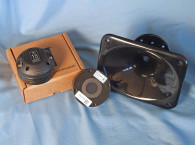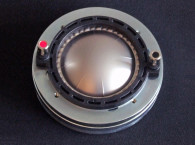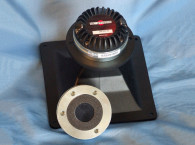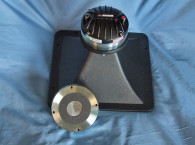
B&C Speakers’ new polymer diaphragm neodymium DE550-8 compression driver is coupled with B&C Speakers’ ME20 90° × 60° horn. (This horn was previously featured along with B&C Speakers’ DE14TN in the April 2014 issue of Voice Coil.) The DE550-8 joins B&C Speakers’ extensive series of 1” throat ferrite motor compression drivers, now numbering 14 models, including the new compact DE110.
The DE550-8 has a 25 mm (1”) throat diameter. It is coupled to a polymer diaphragm with a 51-mm (2”) diameter voice coil wound with aluminum wire, making the DE550 the largest diameter voice coil in B&C Speakers’ 1” throat series (see Photo 1). Other features include a neodymium ring magnet motor structure, nominal 70-W rated power handling (140 W continuous), an injection-molded aluminum black heatsink, and solderable terminals. The horn supplied with the DE500-8 is B&C Speakers’ 1” throat constant directivity cast aluminum ME20 horn. This horn has a solid 1.5-Hz cut-off frequency.
I used the LinearX LMS analyzer to produce the 300-point sine wave impedance plot shown in Figure 1. The solid black curve was taken with the DE550 mounted on the ME20 horn. The dashed blue curve represents the compression driver without the horn. With a 6.3-Ω DCR, the minimum impedance of the DE550/ME20 was 8 Ω and at 6.7 kHz.




For the next group of frequency response tests, I free-air mounted the DE550/ME20 without an enclosure and measured both the horizontal and vertical on and off axis at 2.83 V/1 m, using a 100-point gated sine wave sweep from 0° on axis to 60° off axis. Figure 2 displays the DE550/ME20’s on-axis frequency response, which is smooth with no major anomalies ±3 dB from 1 kHz out to 18 kHz and a declining response, as frequency increases typical of constant directivity horns. B&C Speakers’ recommended crossover frequency for the DE550 is 1.2 kHz with a second-order or higher high-pass filter.
Figure 3 shows the on- and off-axis response in the horizontal plane. Figure 4 shows the normalized horizontal plane response. Figure 5 shows the on- and off-axis response in the vertical plane. Figure 6 shows the normalized vertical plane response. Last, Figure 7 has the two-sample SPL comparison, showing the two DE550 compression driver samples to be very closely matched.



For the remaining series of tests, I used the Listen AmpConnect ISC analyzer and 0.25” SCM microphone and power supply to measure distortion and generate time-frequency plots. For the distortion measurement, I once again mounted the DE550/ME20 combination in free air and set the SPL to 104 dB at 1 m (1.84 V determined by using a pink noise stimulus generator and internal SLM in the SC12 software). Next, I measured the distortion with the Listen microphone placed 10 cm from the horn’s mouth (see Figure 8 for the distortion curves).
Following this procedure, I set up SoundCheck 12 to generate a 2.83 V/1 m impulse response curve and imported the data into Listen’s SoundMap Time/Frequency software. Figure 9 shows the resulting cumulative spectral decay (CSD) waterfall plot. Figure 10 shows the short-time Fourier transform (STFT) plot. B&C Speakers is a very consistent manufacturer that produces speakers with excellent build quality and performance.
For more information, visit www.bcspeakers.com










